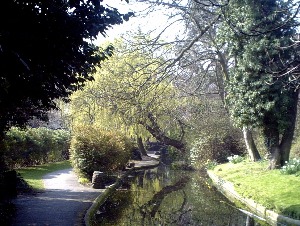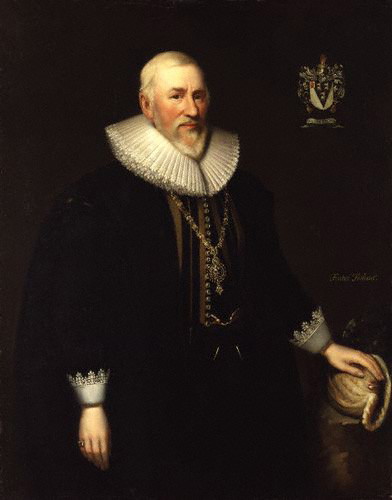
DID A DIAMOND CHANGE HISTORY?
London’s fate as a city may have been determined by a jewel. King James I wanted to advance favor with his wife and queen, Anne of Denmark, by buying her a pendant with a single exquisite diamond. He sought the counsel of his jeweler.

The royal jeweler, Hugh Myddleton, was to play a decisive role in the future of London, and of England’s development. In 1612, Myddleton convinced the King to allow him to cut a deep trench through Theobald’s park, on royal country estate. The goal? Like the Roman’s before them, London’s denizens were running out of fresh water. The nearby green countryside had water aplenty. When Myddleton sold him the sparkler, he also sold him a way to keep London prospering through renewing the city’s water supply.
Jewels, royals, and the very familiar name of Myddleton (perhaps not related to the Duchess of Cambridge, the former Catherine Middleton) may call to mind a certain Royal Wedding of 2011. Whether or not related, any Middleton would be proud of the distinguished contribution to the success of London that Hugh Myddleton, King James, and the New River have created.
HISTORY OF CHANGES IN WATER SYSTEMS
The New River is an early demonstration of the changing technology of water conveyance. Like the Romans, the English first used gravity. But then later force – provided by horses, people, and finally manual pumps took a more decisive role. Steam, and later electric, pumps finished the job. Crisis sometimes stimulates innovations; when cholera decimated London’s population in 1846, the world’s first water treatment plant was invented in England. (Building the World, p. 99)
CHARITABLE CONTRIBUTIONS

Myddleton granted charitable provisions to London’s poor, selecting a section of London where alms were appreciated by residents of St. John Street and Aldersgate Street. The King and Myddleton may have set one of the first examples of charitable giving. In later times, it became common to reserve a portion of the profits for charity; later, in some countries, tax deductions were systematically allowed for charitable contributions.
WATER SUPPLY AND CITY GROWTH
London once faced limits to growth. Now it is one of the largest cities in the world. What was started by an entrepreneur and a King is now Thames Water. London’s pubs serve up an ample supply of liquid refreshment; citizens of the realm consume about 150 liters (33 gallons) per day — a lot less than their Roman ancestors who enjoyed 750 liters (198 gallons) for the entire SPQR or Senatus Populusque Romanus. When the Tiber River became compromised as a source of fresh water, Romans discovered a way to bring fresh water from springs surrounding the city, piped through the countryside via aqueducts. China is another example; during Beijing Olympics, it was necessary to improve the Grand Canal in order to meet the needs of visiting athletes and tourists.
Document of Authorization
The below are excerpts from the document that authorized the construction and maintenance of the New river in 1605.
A.1.3 Jas. I. c. 18
Statutory Foundation 1605
An Acte for the bringing in of a fresh Streame of running water to the North parts of the Citie of London.
1. It shall be lawfull to the Lord Mayor, Comminaltie and Citizens of the Citie of London…to beginne and continue the laying out of such convenient Limits of fround..and in that place that they shall find to be most apt and meet for that purpose, to have and take for the purpose abovesaid the use and libertie of such and so much ground.
2….and to have free Passage to and from the sayd New Cut or River with men, horses, cart and carriages.
3. In consideration whereof, The Mayor, Comminaltie, and Citizens of London, and their Successours shall make such satisfaction or composition to and with the Lords, Owners, and Occupiers of the same grounds, through which the newe Cut or River shall be made…
5. Provided always, and bee it enacted, that if in the New Cutte there happen any Breaches, Inundation, or Hurts, the Mayor, Comminaltie and Citizens of London, shall from time to time stoppe the Breaches at their owne charges, and sufficiently maintaine them from time to time, and make sufficient recompense to the Partie grieved for the Damage sustained by the same Breaces rising by their default, to be recovered by Action of the Case grounded upon this Statute.
6. And bee it further enacted…that for better maintenance and preservation of the sayd River or new Cut, and of all the water therein running, to be brought to the Citie of London, the same small be subject to the Commission of Sewers;
7. …bee it enacted, That all such things as shall be done, at any time hereafter, for the Scouring, cleansing, amending, and conservation of the sayd new River or Cut, shall be at the onely costs and charges of the Mayor, Citizens, and Communaltie of the Citie of London.
From Bernard Rudden, The New River: A Legal History (Oxford: Clarendon Press, 1985)
VOICES OF THE FUTURE: Discussion and Implications
Eminent domain: When public construction crosses private property for the general good, government can take property by eminent domain. What does the New River law say about land needed? How about the Big Dig, Boston’s Central Artery Project or the Bundesautobahn or formerly Reichsautobahn of Germany?
Public/private: The New River was built as a public/private venture between entrepreneur Hugh Myddleton and regent King James I of England. Yet, once completed, the Mayor, Comminaltie and Citizens of London would be responsible for maintenance and repair. Three levels of responsibility can be traced: national, municipal and private. In the future, how can new ways of creating irrigation and drinking water benefit from approaches taken in building the New River?
Water and environment: The New River is one of the first legal documents to specify and require the preservation of water environmentally. In sections 6 and 7 of the Statutory Foundation of 1605, the “Scouring, cleansing, amending, and conservation” of the New River is mandated. How do our public water laws of today compare?
RESOURCES
To read the complete chapter, members of the University of Massachusetts Boston may access the e-book through Healey Library Catalog and ABC-CLIO here. Alternatively the volumes can be accessed at WorldCat, or at Amazon for purchase. Further resources are available onsite at the University of Massachusetts Boston, Healey Library, including some of the following:
Building the World Collection Finding Aid
(* indicates printed in Notebook series)
Lives of The Engineers with an Account of their Principal Works. Samuel Smiles. Vol. I. London: John Murray, 1861. Excerpt from Chapter III on the New River.
Internet
“Thames Tunnel,” PBS. From wonders of the World, Building Big.
http://www.pbs.org/wgbh/buidingbig/wonder/structure/thames.html.
“Story of the New River” and “Technology and Science” from
http://www.waterinschools.com/newriver/technology.html
“New River Path” Ramblers Association, Walking in Britain.
http://www.ramblers.org.uk/info/paths/newriver.html
*“Cities of Science – London – Aqueducts to straighten the flow,” City of Science.
http://www.citiesofscience.co.uk/go/London/ContentPlace_1902.html
*”New Chief for UK-Focussed Thames Water,” Thames Water Utilities.
http:www.thames-water.com/UK/region/en_gb/content
*River Lee,” Lee Education Network and London’s Waterway Partnership.
http://www.riverlee.org/uk/mainpage.htm

Building the World Blog by Kathleen Lusk Brooke and Zoe G Quinn is licensed under a Creative Commons Attribution-NonCommercial-NoDerivs 3.0 Unported License.
